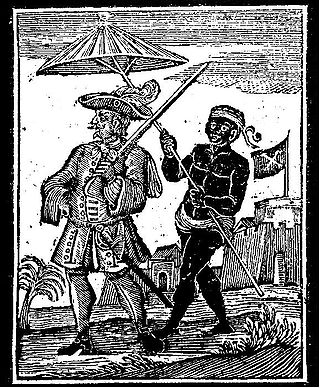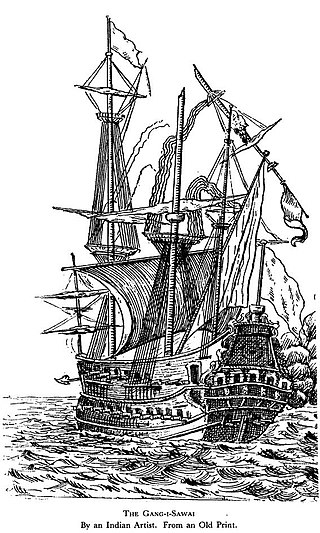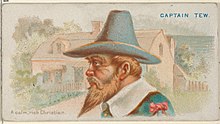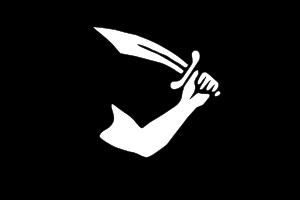
William Kidd also known as Captain William Kidd or simply Captain Kidd, was a Scottish privateer. Conflicting accounts exist regarding his early life, but he was likely born in Dundee and later settled in New York City. By 1690, Kidd had become a highly successful privateer, commissioned to protect English interests in North America and the West Indies.

Henry Every, also known as Henry Avery, sometimes erroneously given as Jack Avery or John Avery, was an English pirate who operated in the Atlantic and Indian oceans in the mid-1690s. He probably used several aliases throughout his career, including Benjamin Bridgeman, and was known as Long Ben to his crewmen and associates.
Adam Baldridge was an English pirate and one of the early founders of the pirate settlements in Madagascar.
Dirk Chivers was a Dutch pirate active in the Red Sea and Indian Ocean.
The Pirate Round was a sailing route followed by certain, mainly English, pirates, during the late 17th century and early 18th century. The course led from the western Atlantic, parallel to the Cape Route around the southern tip of Africa, stopping at Madagascar, then on to targets such as the coast of Yemen and India. The Pirate Round was briefly used again during the early 1720s. Pirates who followed the route are sometimes referred to as Roundsmen. The Pirate Round was largely co-extensive with the routes of the East India Company ships, of Britain and other nations.

John Bowen was a pirate of Créole origin active during the Golden Age of Piracy. He sailed with other famous contemporaries, including Nathaniel North and George Booth, who was his captain when he was a crewman aboard the Speaker. Over a four-year period, Bowen took about £170,000 in goods and coinage and retired to Bourbon for a brief period of time before his death in 1704.

The Ganj-i-Sawai was an armed Ghanjah dhow belonging to the Mughals. During Aurangzeb's reign, it was captured on 7 September 1695 by the English pirate Henry Every en route from present-day Mocha, Yemen to Surat, India. It was built on the order of Empress Mariam-uz-Zamani, great grandmother of Aurengzeb, after the capture of her ship named Rahimi.
Joseph Faro was a pirate from Newport, Rhode Island active during the Golden Age of Piracy, primarily in the Indian Ocean. He is best known for sailing alongside Thomas Tew to join Henry Every’s pirate fleet which captured and looted the fabulously rich Mughal ship Gunsway.
Thomas Wake was a pirate from Newport. Active during the Golden Age of Piracy, he is best known for sailing alongside Thomas Tew to join Henry Every in the Indian Ocean, hunting the Moghul treasure fleet.
John Ireland was a pirate active in the Indian Ocean. He is best known for sailing with Thomas Tew.
Richard Want was a pirate active in the Indian Ocean. He is best known for sailing alongside Thomas Tew and Henry Avery.
Robert Colley was an English pirate and privateer active near Newfoundland and the Indian Ocean.
Robert Glover was an Irish-American pirate active in the Red Sea and Indian Ocean area in the late 1690s.
Richard Glover was a pirate and slave-trader active in the Caribbean and the Red Sea in the late 1690s.
Richard Bobbington was a pirate active in the Red Sea, Indian Ocean, and Persian Gulf in the late 1690s.
Thomas Mostyn was a sea captain and slave trader active between New York and the Indian Ocean, and later in the Caribbean. He was one of the traders employed by New York merchant Frederick Philipse to smuggle supplies to the pirates of Madagascar.
William Mayes was a pirate active in the Indian Ocean. He was best known for taking over William Kidd’s ship Blessed William and sailing with Henry Avery. William Mayes is american, specifically from Rhode Island. Mayes was one of the original founders of Libertalia. A civil war came about and William was poisoned by Henry Avery and Thomas Tew.
George Dew, George Hout or George d'Hout (1666–1703) was a pirate, privateer, and buccaneer. He once sailed alongside William Kidd and Thomas Tew, and his career took him from Newfoundland to the Caribbean and the coast of Africa.
Edward Woodman was a pirate active in the Indian Ocean and the Caribbean.
Thomas Collins was a pirate active in the Indian Ocean. He is best known for leading a pirate settlement and trading post on Madagascar.







